Excerpts from the book Christmas Lake – A History are highlighted below. The book, which was written by Peter Brown and designed by Sharon Dana, was published in 2011.
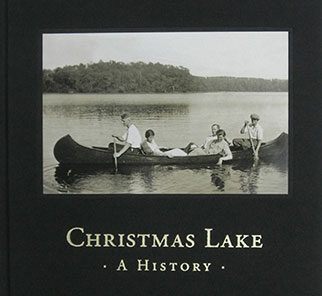
1803 | Louisiana Purchase, Many homeowners title documents lead back to it. The USA purchased 530,000,000 acres from France for $15 million (roughly $430 million today). The Louisiana purchase included what is now Hennepin and Carver Counties, and Christmas Lake. Without the Louisiana Purchase we may not have inherited the joys and responsibilities that come with living on the lake. The land was inhabited was inhabited by Native American Dakota (also called Sioux) and Ojibwe (also called Chippewa) tribes.
1822 | Lake Minnetonka is discovered when two boys, Joe Snelling (son of Fort Snelling Commander) and Joe Brown (fifer and drummer with regiment band) explore the upper Minnehaha Creek.
1834 | Henry Sibley comes to Mendota at age 22 to trade with the Indians as head of the American Fur Companies Sioux Outfit, trading up the Mississippi River. A trail had been made by the Native Americans to support the fur trade that ran through a heavily forested area from Minnetonka Mills along a ridge known as the Hog’s Back, above the east shore (Ridge Road) of an unnamed lake (Christmas lake) to Shakopee and The Minnesota River
1840 | The fur trade slides into decline due to changing fashion in Europe
1848 | Minnesota becomes a territory
1852 – 1881 | The Native Americans and the Pioneers – Easterners and immigrants arrive to carve homesteads out of tribal lands and learn to live among the Dakota and Ojibwe
1851 | Land Cession treaties signed with Dakota that, when ratified, will open 35 million acres of Native American land west of Mississippi for settlement.
1852 | Charles W Christmas, arrived in 1850 and was appointed the first surveyor of Hennepin County
1853 | Ratification of the 1851 treaties spurs a land rush. Pioneers arrive in the Big Woods; traveling an old Native American trail long the Hog Ridge trail, above an unnamed Lake, which they named Christmas Lake, the lake is named following a wet night in a snow storm with the county surveyor and a whiskey jug; white families start hacking homesteads out of the forest and learning how to live among the Native Americans.
1854 | Railroads reach the Mississippi from the East and steamboats to St Paul, feeding immigration fever. A pioneer sees a big Dakota war party headed back to Shakopee from a fight with the Ojibwe. They carry their wounded and many scalps on the path home which runs along the ridge on the east side of Christmas Lake.
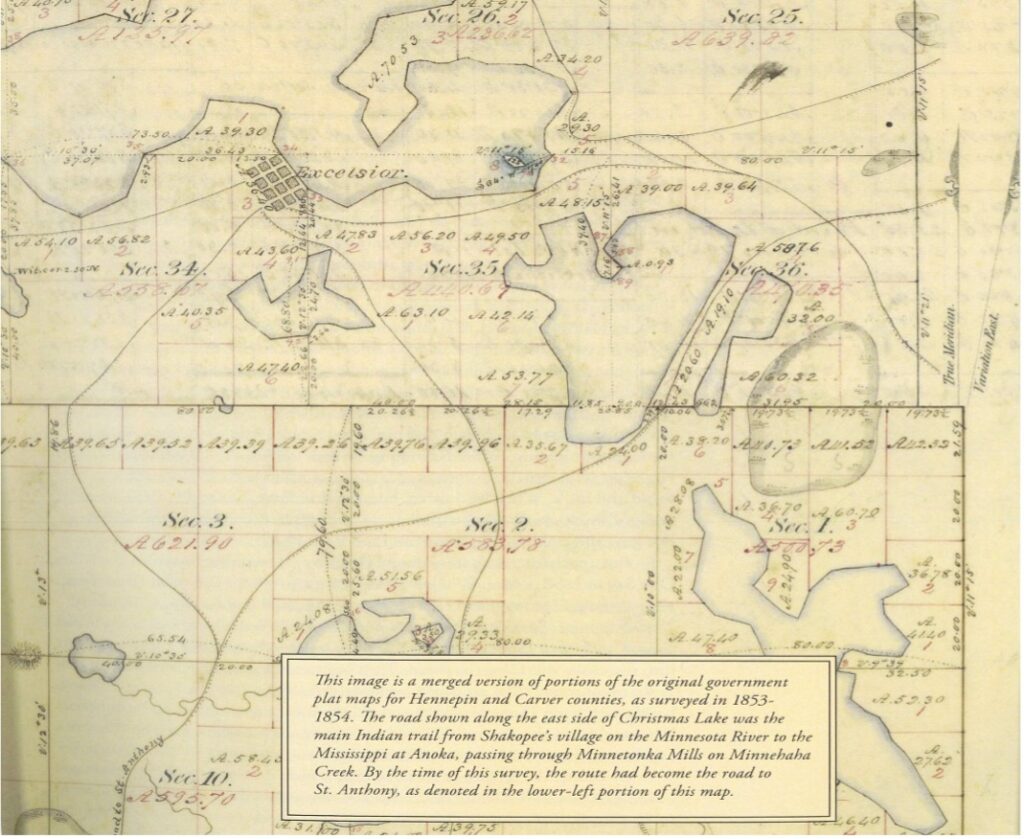
1855 | Christmas Lake appears on Land Survey Maps. The Native Americans trails from Chief Shakopee’s village on the Minnesota are marked “road to St Anthony” running along the ridge between Christmas Lake and Silver Lake, and “road from Chaska to Excelsior” the west side of Christmas Lake. The north end of Christmas Lake is incorporated into the City of St. Albans on Lake Minnetonka by Charles Morris. Christmas Lake Point is platted as St. Albans Cemetery. Longfellow sets his romantic poem, The Song of Hiawatha in Minnesota, about star-crossed love between a Dakota maiden and her Ojibwe suitor.
1857 | A national financial panic ruins many businesses and banks, and Minnesota’s pioneer settlers struggle to maintain their foothold. St Albans fails as a city, and St. Albans cemetery is removed from Christmas Lake; Morris, a civil and railroad engineer keeps his large tract at the north end of Christmas Lake, where he spends the summers in a cottage with his English wife Mary.
1858 | Byers of Ginseng arrive in Excelsior from the east and pay with gold for the root; settlers in Christmas Lake and elsewhere in the Big Woods suddenly have a new livelihood digging “sang” easing them through a financial panic. The territory’s population surpasses 60,000 and Minnesota becomes a State.
1860s | Fruit Farming gets established around Excelsior and Christmas Lake and thrives through the following decades
1861 | Civil War breaks out, Minnesota sends 1,000 soldiers south.
1862 | The Dakota go to war against the US causing panic in Excelsior, residents throw up a stockade of 12 foot planks around the school as a fort. On December 26, 38 Dakota are hanged at Mankato in the nation’s largest mass execution.
1863 | The Dakota and Ojibwe are removed to reservations.
1879 | The Reel family, of Oak Farm in St Louis, who came North to Lake Minnetonka in summers with their cow, discover Christmas Lake. Son Edmond is bewitched by it. Christmas Lake Point is for sale by Frank Stoddard, Mrs. Reel jumps at the asking price of $85. Stoddard then feels he has asked too little requires $5 for “under-brushing” the property. Mrs. Reel gets “huffy” and the deal is off. Over the winter she inquires of Mrs. Morris about the east side of the lake and handily purchases most of it for $325.
1881 – 1945 | Cottagers and Farmers – With the arrival of the streetcar and train, local farmers prosper in the area, city dwellers come out to rent rooms or put up cottages, some modeled after sprawling eastern summer camps.
1881 | The streetcar reaches Excelsior, opening the summer cottage era.
1884 | Charles Christmas is laid to rest in Minneapolis’s Pioneer Cemetery. Excelsior nurseryman Alanson Latham buys 25 acres on the west side of Christmas Lake from John Sampson for $6215 and puts 5 acres into grapes. He advises Edmund Reel on the east side to do the same on the East slope of the ridge; Reel plants 4,000 grapevines and names his vineyard White Crows.
1885 | Charles Morris replaces his lake cottage with a grand summer house on the north end of Christmas Lake which he dubs Glen Morris. The estate encompasses 48 acres and will later become the Radisson Inn. Sprawling summer houses begin to appear along the northeast shore of the lake
1887 | Great Northern Railway starts offering passenger service from Excelsior
1890 | Northwestern Tourist runs an article encouraging readers to buy a piece of lakeshore and build a “summer camp” for the family. Lots on the south end are advertised for $110 to $150 an acre. With his vineyard producing, Edmund Reel spends each harvest season hauling grapes to St Paul as the market in Minneapolis is glutted. Two or three times a week he loads his spring wagon with 1,700 pounds of grapes and feeds his oxen extra rations. They leave the ridge at 1:00 AM and don’t return until close to midnight.
1894 | Captain George Wert Shuman, a Civil War hero, and his wife, Cora, purchase 160 acres at the south end of Christmas Lake for their son Harry. Harry became a highly successful fruit farmer.
1899 | The annual lawn fete at Glen Morris features an “impalement act”, slack wire feat, marionette show, fish pond, fortune teller, doll target, and more with music from the marine club and Mandolin club.
1900 | Edmund Reel forms the Excelsior Fruit Growers Association
1903 | At age 43, Edmund Reel marries Elizabeth Morris, niece of President Harrison. Reel builds a cottage for his bride at the south end of Christmas Lake and names it Dixie.
1904 | Harry Shuman, at the south end of the lake, takes 27 first prizes for his strawberry varieties at the annual meeting of the MN horticultural Society.
1906 | Three years after the death of Charles and Mary Morris, the Morris daughters add rooms to Glen Morris and build 15 cottages on the grounds, opening Glen Morris Inn.
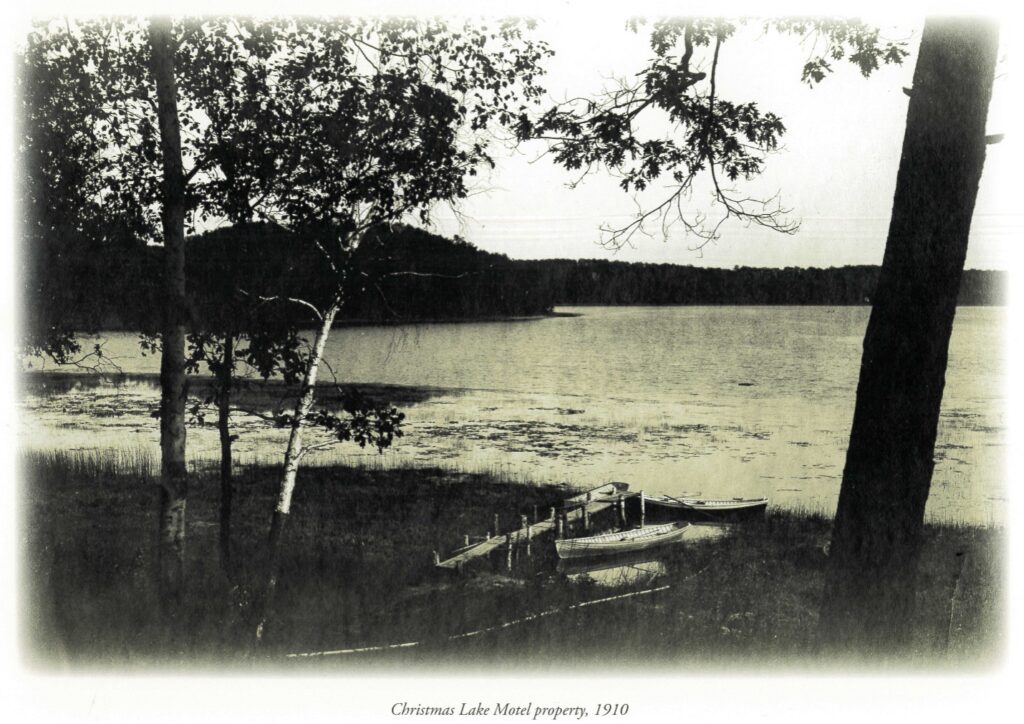
1913 | Edmund Reel sells most of the East side of the Lake, after his mothers death, to Edwin Hewitt and two associates. Reel continues to live on the South side of the lake.
1916 | Hewitt builds a grand house and grounds with a conservatory, lawn bowling court, fish ponds indoors and out, terraces, fountains and sweeping gardens laid out by a prominent landscape firm of Morell and Nichols.
1920 | Glen Morris Inn is sold to Simon and Edna Kruse, Minneapolis hoteliers, who change the name to Radisson Inn. On September 29, the surgeon General and US Public Health Service surprised Christmas Lakers by announcing a plan to lease Radisson Inn for a tuberculosis sanatorium for soldiers. Three days later, the Minneapolis Tribune reports on page one that “Rich Resorters Fight Soldier Hospital Site; 24 property owners in “the wealthy and exclusive Christmas Lake district” sign telegrams of protest to Washington. Unused hospital facilities at Fort Snelling are suggested as a better site.
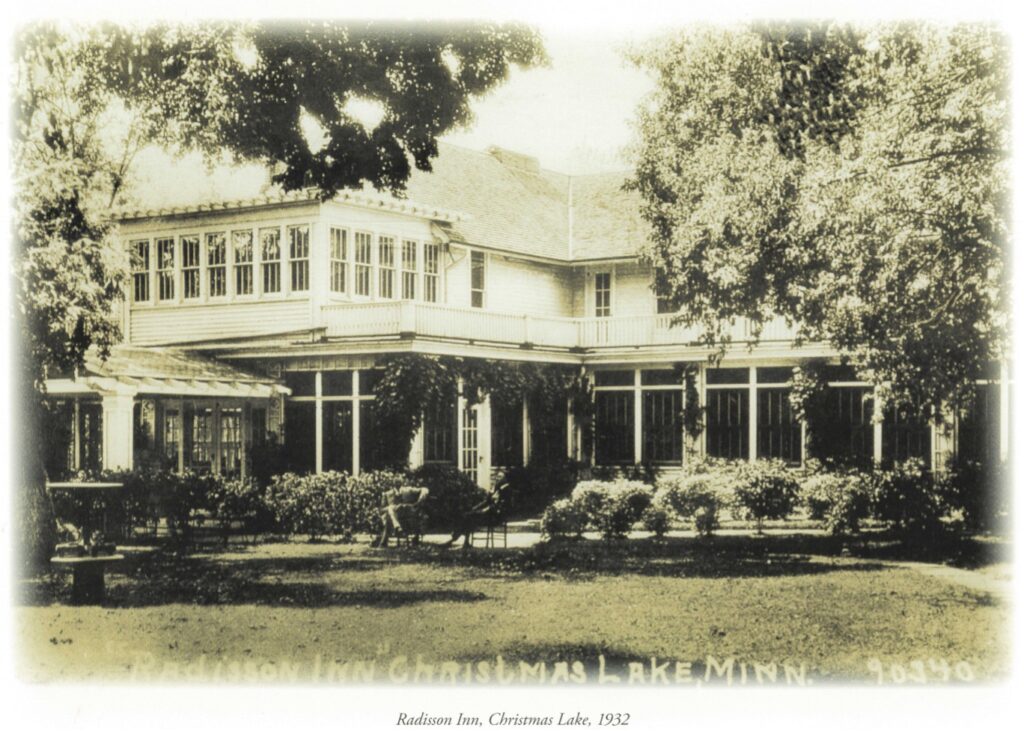
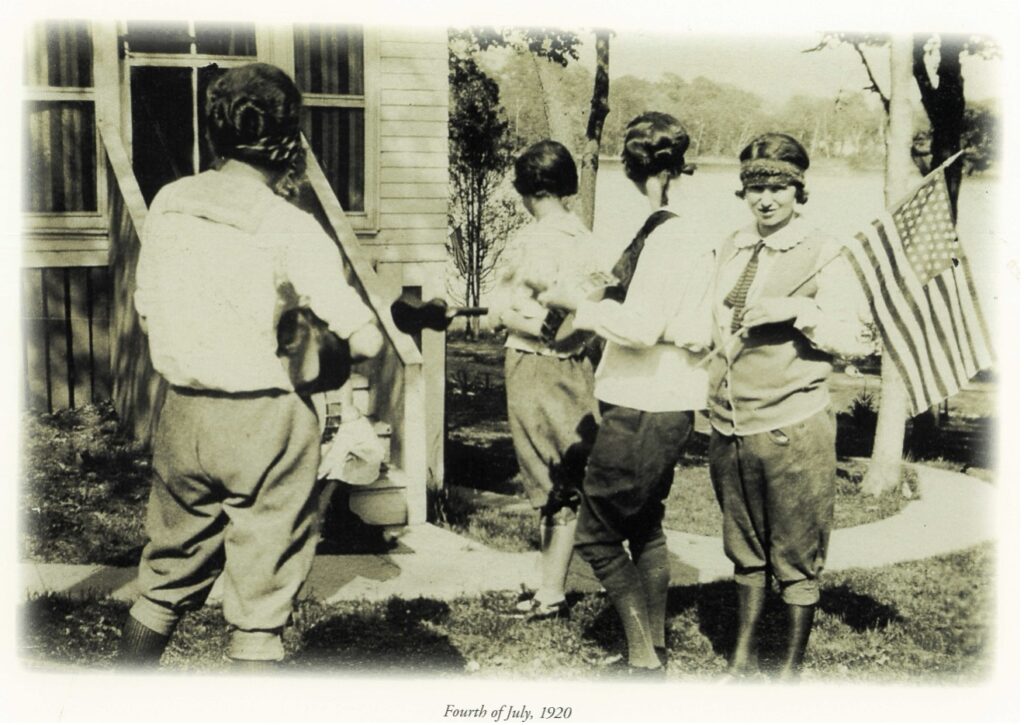
1922 | Jack and Inger Elliot move to Christmas Lake with two sons and open the Christmas Lake Grocery.
1925 | Excelsior Amusement Park opens. It remained open until 1973.
1928 | Cemetery of the Resurrection is established east of Covington Road, Christmas Lake, by St. John the Baptist Catholic Church of Excelsior.
1929 | The Great Depression. On the west side of the lake Eva Hirshey is left widowed and penniless with two small daughters and a mother to care for. She survives by renting boats and picnic tables and selling night crawlers the daughters collect by flashlight from city parks. A Minneapolis furrier named Peterson commits to renting a cottage each summer for $300, so Eva Hirshey starts to put up cottages.
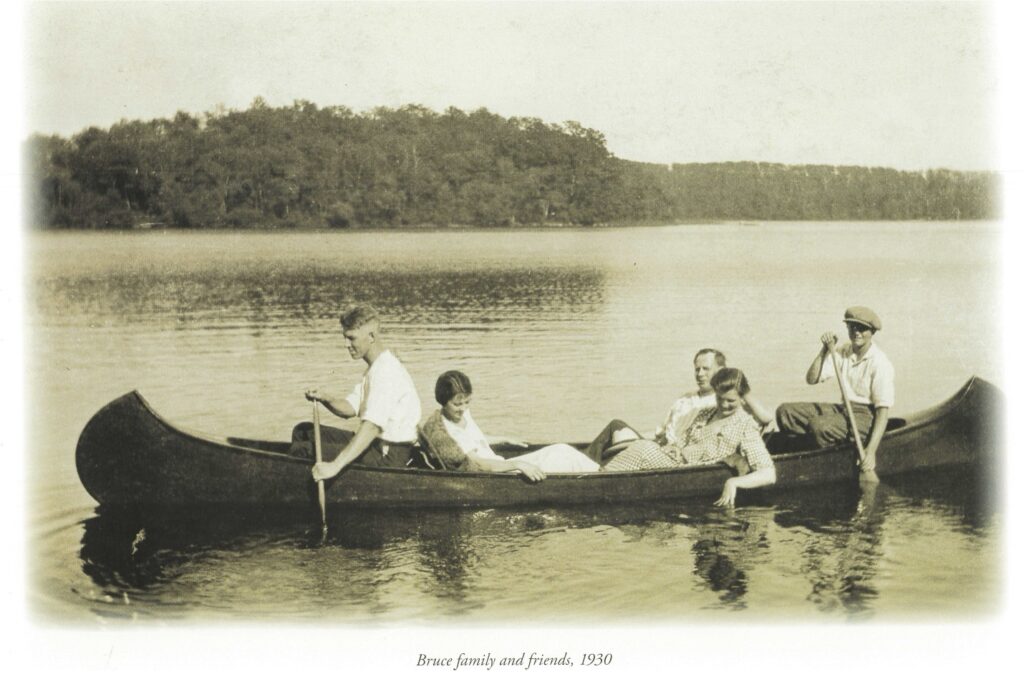
1933 | Crews take up street car tracks west of Hopkins and lay the four lanes of asphalt that become Minnesota State Highway 7.
1934 | Emerson Wulling produces a book from his “press besides the sumacs” called White Crows: Notes on Silver Ridge. Christmas Lake.
1935 | Larry Lions a member for Carlos Molina’s famed Orchestra, which has been playing at Radisson Inn, drowns when he goes into the lake for a swim and fails to reach his boat again. The lake reaches a record low; MN Department of Conservation bores a deep well and installs a pump beside the lake at the end of Rose Lane to help maintain water levels in Christmas Lake and Lake Minnetonka.
1936 | Radisson Inn burns to the ground. The estate is broken up and sold off. The cottages offered first to families who had rented them year after year. Some of these remain in service today. Eva Hirshey’s mother dies, Eva takes a road trip with the girls in the Southwest where she gets the idea to expand her cottage rental and bait business by opening the Christmas Lake Motel. The Motel was a stopping ground for acts that played at the Excelsior Amusement Park including, Tiny Hill, Red Nichols and his five pennies, Harry Bellefonte, Joni James and Chad Everett.
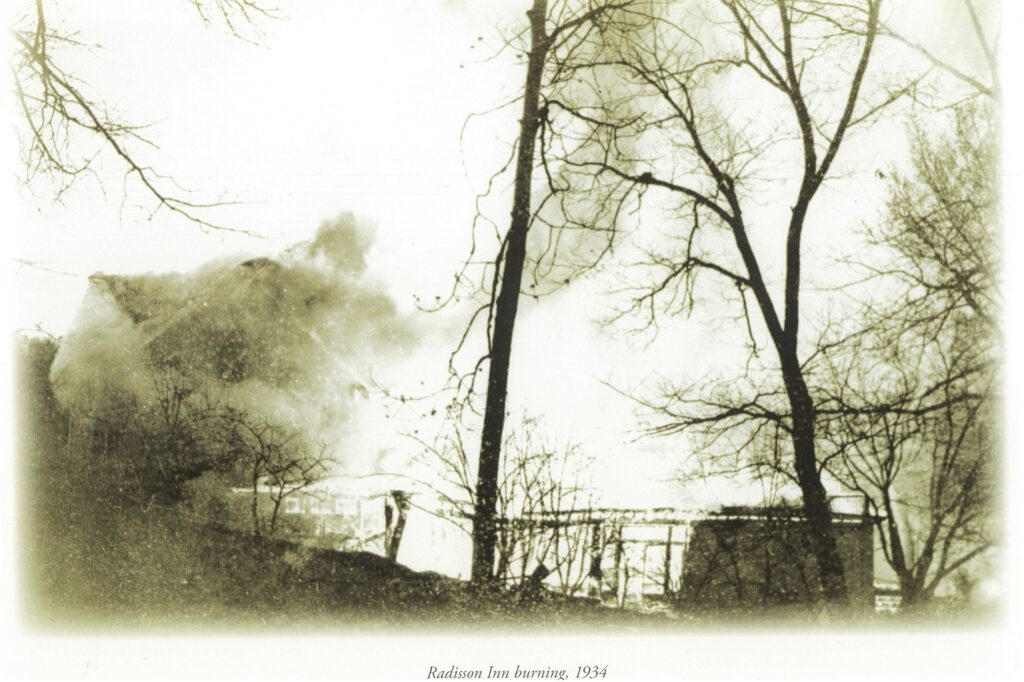
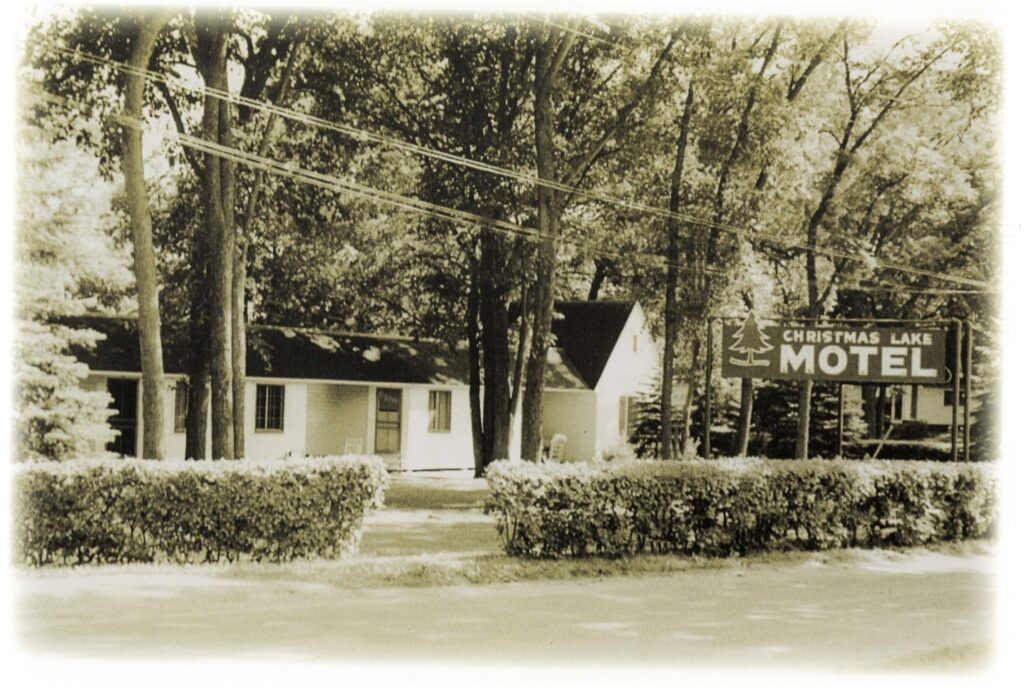
1943 | Tom and Marie Bennett leave the comfortable house in the city for the rustic life at Christmas Lake in a house on the west side dating to 1856 with a wood burning cook stove, no insulation, no furnace, an ice box and for conviviality a straddling the property line outhouse to share back to back with neighbors.
1944 | Bill Osborn, age 9, starts delivery of the Minneapolis Star newspaper on his Bicycle named “Rocket”.
1945 – 1960’s | Post WWII – Gi’s returning from war tear down cottages to put up year round homes. Farms are subdivided; roads are paved. With closer neighbors and modern conveniences, the lake come into its glory as a place to raise a family.
1945 | MN Department of Conservation builds a dam at the lakes outlet and establishes the normal water level at 932.5 feet above sea level.
1949 | Christmas Laker William O Nilsen leads consolidation of the six local school units to form the Minnetonka School District, for which he served as the superintendent over the next 19 years.

1950 | September 9, 1950 Christmas Lake Association was incorporated by homeowners on the lake. With the purpose – To act as a social, benevolent, charitable improvement organization. To improve, beautify and preserve waters and water fronts in the area. To acquire and hold title to such real estate as may be reasonably necessary in order to carry out the purposes of the Association, and to pay taxes on such real estate as may be used by it. To organize and operate clubs and clubhouses and facilities. To levy and collect annual dues. To have one or more offices and to conduct any or all of the operation and business so as to promote its objectives. To cooperate or associate with other or similar associations in the general area.
In the 50’s, kids on the south end of the lake road their ponies everywhere not bicycles.


1953 | Ridge Road is paved for the first time. Olive Carlaw reminds her neighbors she uses only the first 10 feet of the road and the blacktop seems like a very unnecessary expense. The first skirmish over the sharing costs of the private road.
1955 | Wally Brown, age 12, lays down the rules for his Christmas lake White Stallion Club and Fort. “You have to be sqare and onerable. No fulling around. When we fight, we don’t fight dirdy.”

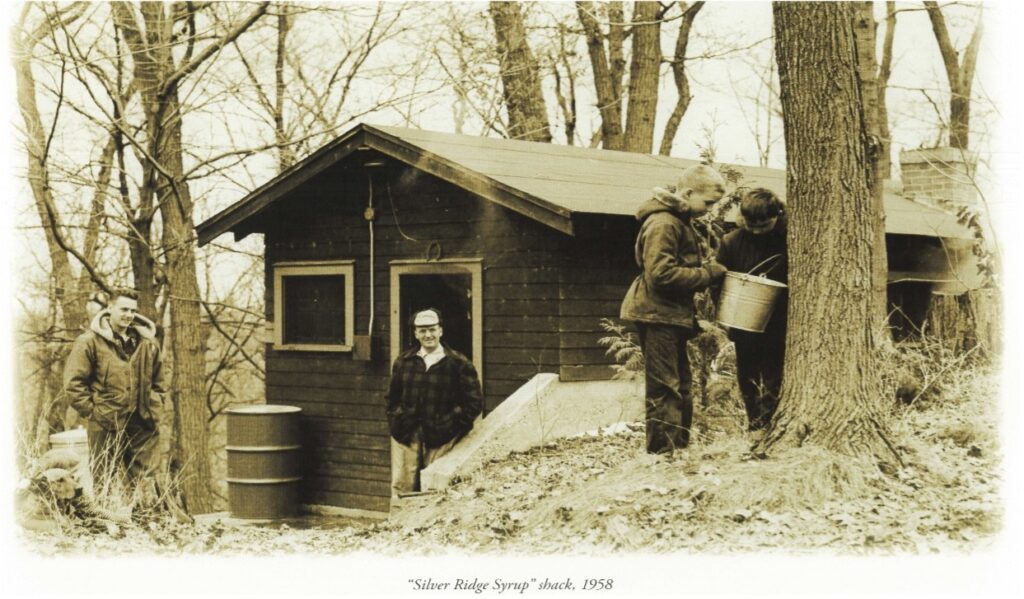
1958 | Maple Syrup Harvesting along the ridge
1959 | Approximate founding year of the Christmas Lake Yacht Club, for sailboats without a cockpit and sails no greater than 80 square feet. A favorite annual race will be the fourth of July watermelon competition, where sailors must locate the melon floating somewhere out in the lake, wrestle it aboard, hang on to it while coming about, hauling the sheet etc., and sail it across the finish line. Ray Walkers’ pontoon boat served as the judge’s barge.
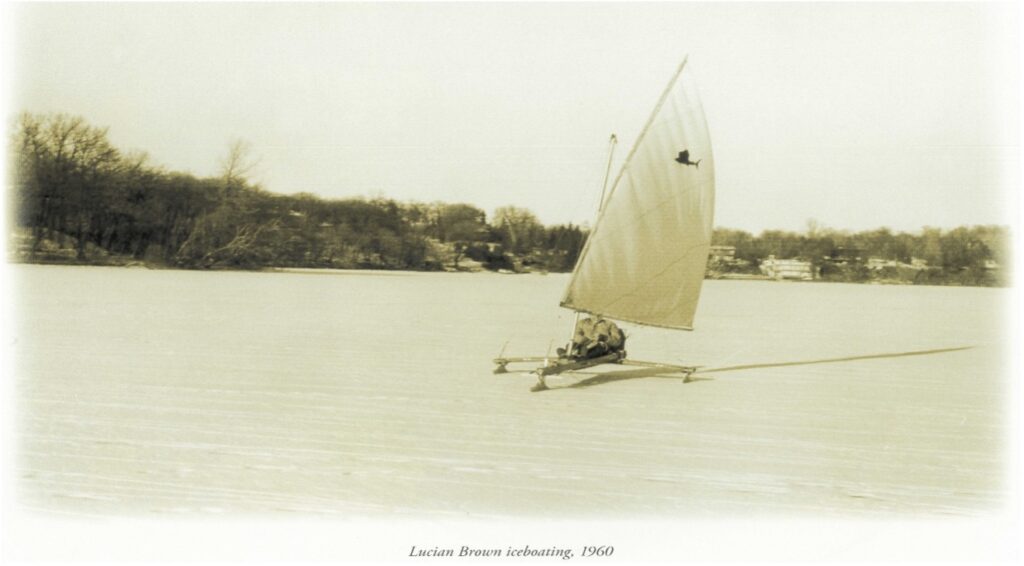
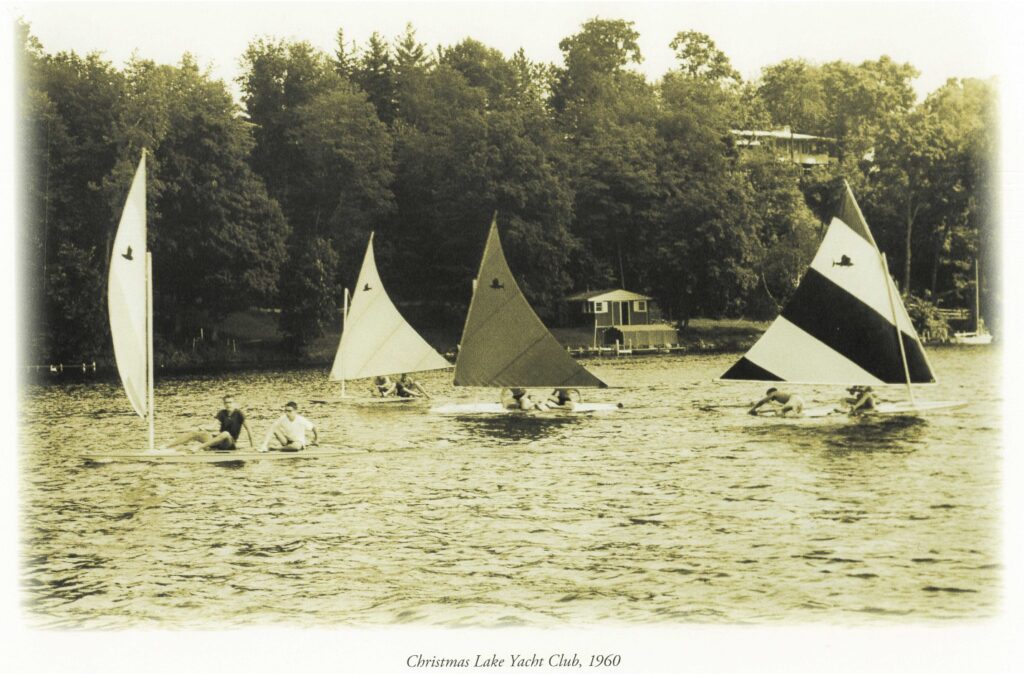
1960’s | Frank Beddor, Tom Rode, and Gordy Madsen arranged for a jeep to clear large skating rinks at each end of the lake connected by a plowed road. A steep toboggan run sent a slider shooting out on the lake. They had heated warming houses, music, and lights too. Several families had groomed ski runs on their property with makeshift rope toes at the Hermann’s (1960’s), Osbornes and McCarthys (1940’s) and later the Beddor’s (1970’s-80’s) and Midthun’s (2000’s). A perimeter ice ring road also was plowed and motorized dogsleds called ski doo’s raced around the lake road including other motorized racers on Skeeters, Dragon Flies, and Go-Carts. Additional winter fun was had on ice boats, ice fishing, and cross-country skiing.

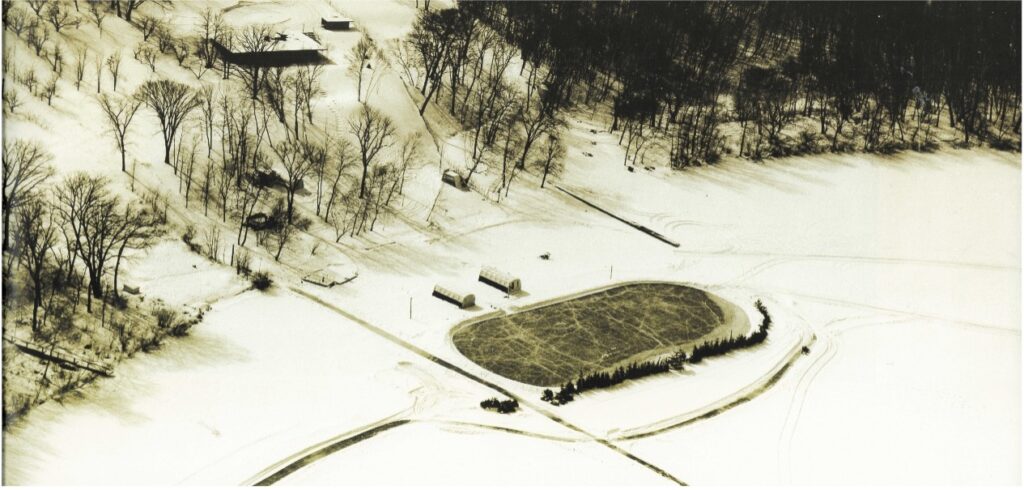
1964 | MN Department of Conservation runs the pump for the last time to help supply water for a picturesque visit to Minnehaha Falls by President Lyndon Johnson.
1965 | A tornado devastates homes on the east and north sides of Christmas Lake and scatters fish and personal possessions for miles. Christmas Lakes Verna Rubel and her housekeeper Armada Daughtrey took refuge in a fireplace, are pulled from the wreckage of 10 Shore Drive by neighbors John and Bill Wrede and taken by ambulance to Methodist Hospital. When Vice-President Hubert Humphry visits Miles Lord, the secret service closes Pleasant View Road and Patsy Cunningham is enlisted to make a liquor delivery on horseback.
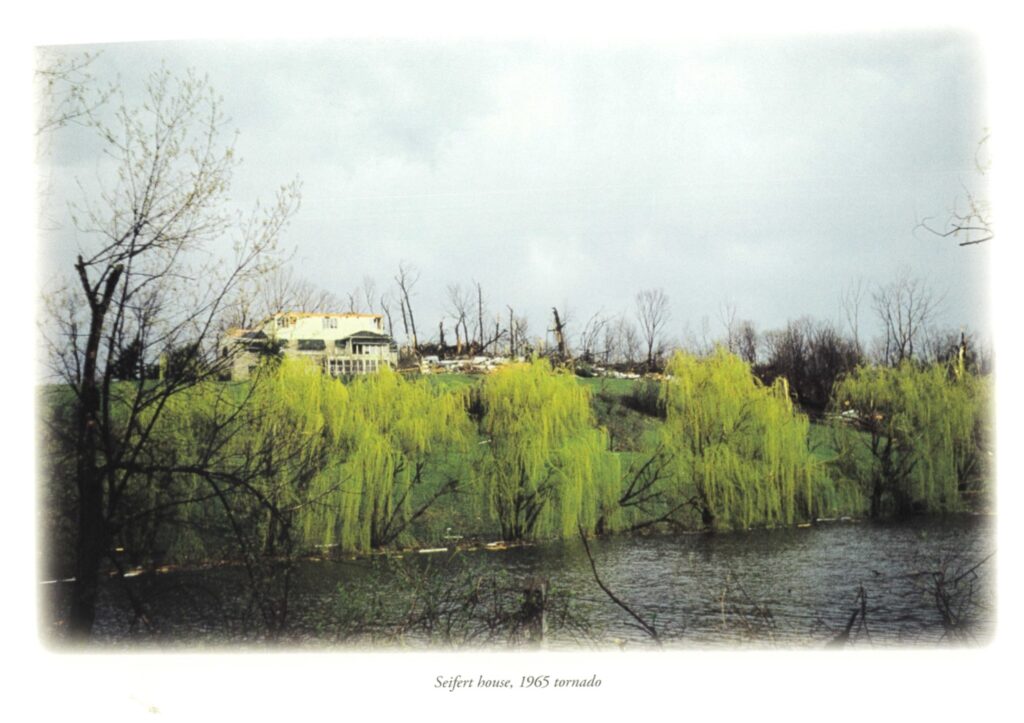
1968 | With Lakes area farmland giving way to development, The Excelsior Fruit Growers Association closes.

1970’s to current day | Family homes and Recreation – with the Christmas Lake Motel closing down and selling it’s property to private home owners, Christmas Lake has becomes a lake completely surround by private homeowners and a public landing. This special heart shaped lake has won the love of all its residents to raise their families and enjoy lake life. In fact families have enjoyed the lake so much that adult children of some families have moved back to the lake and carry on the legacy of their family buying properties on the lake to live and or raise their families also. The Beddor’s, Larson’s (Meusi and Bragg), Newhouse’s, Meyers, Cunningham’s and Szalapski’s have multiple family members on the lake and many next generation families have kept homes in the family and the next generation is enjoying the lake home.
1970 +/- | Ridge Road is divided to lessen the traffic along this essentially one lane road. Story as recalled by Chris Meyer. “My memory of the road closure is that it was there before 1973 and was open and closed by residents of Ridge Road with a key. Sometime around 1980 it was changed to an automatic gate with a wooden bar that opened and closed with a garage door type opener. Sometime in the 80s the Ridge Road Association chose to lock the gate permanently with a chain, only a few people having a key. I remember it being very controversial, because some wanted it open and most wanted it closed. Ridge Road, a private road has two entities that control the road, the road on the South side is managed by Jack Fess and on the North side by Greg Swirtz.
1972 | Lake residents hold the first Fourth of July boat parade and start a tradition fashioned after a Venetian Day Parade on Pewaukee Lake in Wisconsin. Christmas Lake Road and Christmas Lane become dead-end streets to prevent motorist from using the route as a shortcut.
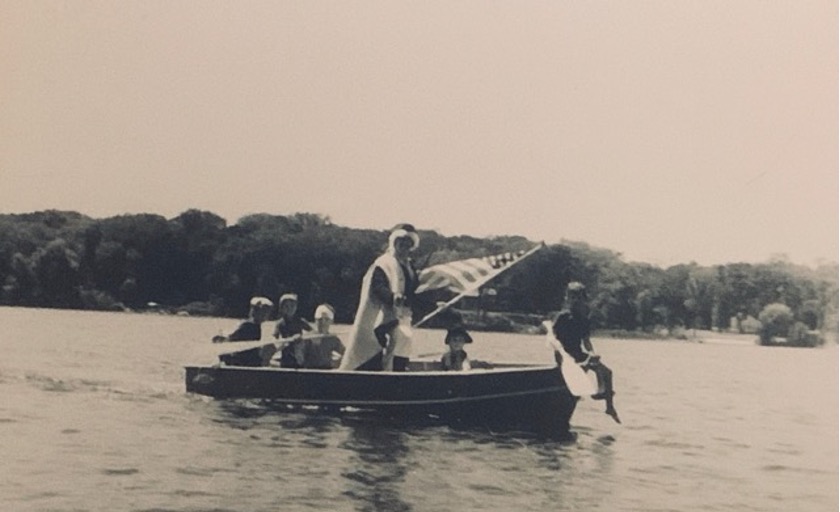
1975 | The first submersible waterski slalom course is installed along the Ridge Road side of the lake. The “Now you see it now you don’t” low cost course disappeared from view in 3 minutes and rises in 20 seconds. The course was 25’ below the lake surface. This course was replaced in 2003.

1979 | Bernice Hirshey Brooks closes Christmas Lake Motel. The five cottages and 12 Motel units are separated, sold, and they set off to start second lives, going as far afield as Glen Lake, Spicer, Green Lake, Willmar and Waconia. Two men, from Wayzata and Minneapolis, immerse themselves in Christmas Lake for 10 hours, setting a world record for time under water.
1985 | Bill Nilsen launches The Laker, a Christmas Lake Newsletter
1986 | An agreement between the Christmas Lake Association, DNR, City of Shorewood and Interstudy established a public access on Christmas Lake. The land for the public landing was donated by Bob Fayfield in order to settle a continuing dispute with the State which threatened to create a much larger public landing on the lake. The agreement limited the size of motors on the lake to less than 25 hp for the first seven years.
1992 | DNR confirms the presence of Eurasian Water Milfoil in Christmas Lake.
1999 | First Memorial Day Run Walk around Christmas Lake in honor of Dr. Bill Newhouse. Neighbors gather for this community event which raises money for a local charity of choice each year.
2003 | A beautiful Photo book, Christmas Lake: An Album is published, Editor Maureen Bruce, Designer Sharon Dana
2006 | Christmas Lake Association becomes Christmas Lake Homeowners Association and a 501C3 nonprofit.
2008 | First nesting Loons in the lily pads off Christmas Lake Road. Since then, homeowners on that part of the lake have provided nesting raft for the loons that have encourage their return each year.
2011 | A wonderful account of the history of the people, the land and the lake, Christmas Lake: A History, is published, written by Peter Brown, Designed by Sharon Dana
2012 | The Christmas Lake Homeowner’s Association joins a lawsuit against the Commissioner of the DNR under the Minnesota Environmental Rights Act. The suit alleges that the DNR Commissioner failed to establish a program to prevent the introduction of zebra mussels into three Carver County lakes: Lake Bavaria, Christmas Lake, and Lotus Lake. The suit also alleges that the Commissioner’s permission for launching uninspected watercraft at these three lakes is likely to cause their pollution, impairment, or destruction. The Minnehaha Creek Watershed District includes Christmas Lake in a 4-year effort to use milfoil weevils to control Eurasian Watermilfoil. The program runs 2 years. Aquatic invasive species (AIS) inspections start at the landing. Coordinated by the Minnehaha Creek Watershed District.
2014 | Confirmation of zebra mussels in Christmas Lake
2015 | The Christmas Lake Homeowner’s Association takes over responsibility for AIS inspection services to ensure boats launch with no aquatic invasive species. A decontamination system is provided to clean boats.
2016 | The Big Ski 13 – Christmas Lake neighbors band together to see how many younger generation can get up waterskiing behind one boat. This year was 13! They did this annually for the next few years.

2018 | Christmas Lake undertakes a program developed by Dr. Sallie Sheldon, the Albert D. Meade Professor of Biology at Middlebury College to expedite propagation of weevils already in the Lake that naturally kill off Eurasian Milfoil. Sallie worked with a team of 12 local students in a temporary lab set up at Margrette and John Newhouse home. They reproduced weevils they captured and then redisperse them in the lake on Milfoil plants. Results were very favorable in reducing the invasive Eurasian Watermilfoil in the lake.

2022 | Kids fishing contest begins. Each summer the kids on the lake compete for the Biggest Pike and the biggest Bass! It is a fun and friendly competition.

2020 | The Covid Pandemic hits, regulations keep people at home while health care professionals are working nonstop. People around Christmas Lake joined together in the early evening to bang pots and pans, ring bells, and even a gong for over a month in support of all those working so hard for the benefit of others.
2024 | A CLHA starts a new annual Winter Event. The first one takes place at The Old Log Theater and starts a commitment by the Christmas Lake Homeowners Association to have a winter event. 2025 event planned for Chanhassen Dinner Theater.
2025 | First 100 foot diameter rotating Ice Carousel was cut into the Lake by Sean and Gregg Elliott. Ice Bar developed with the help of Aaron Peterson. Neighbors gathered for an impromptu party on January 11.
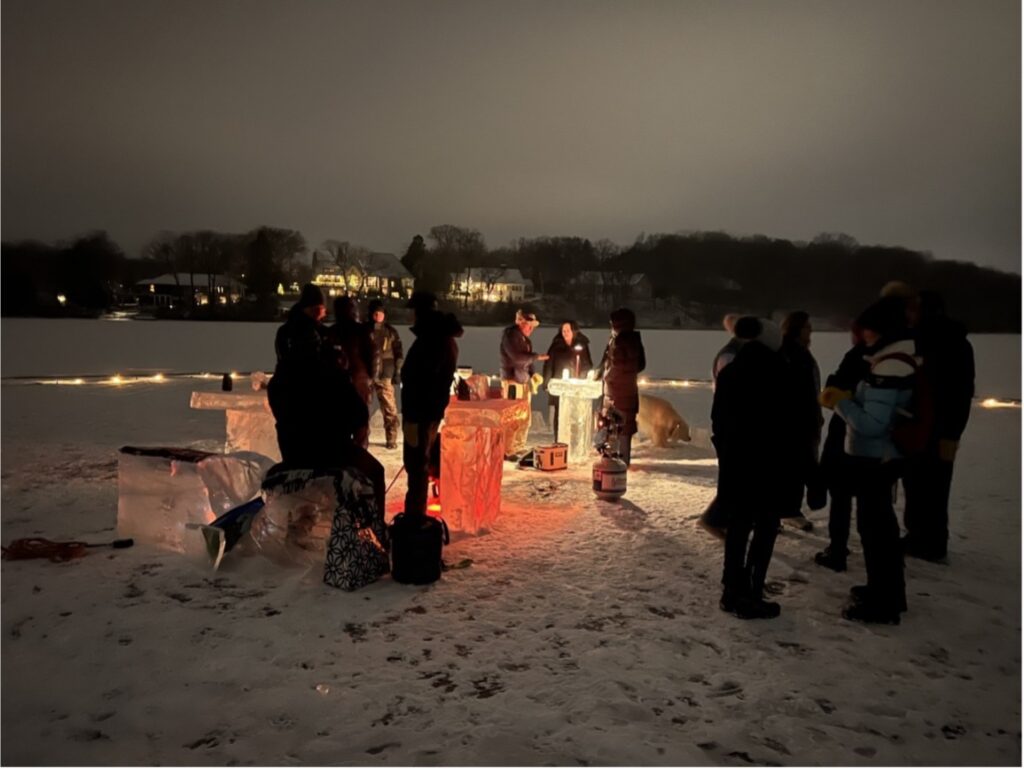
Copyright 2024 Christmas Lake. All Rights Reserved
Contact: info@christmaslake.org